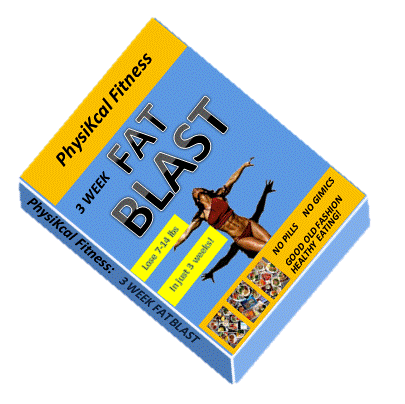
EDUCATION ZONE
Have a question or want to know more about a particular topic. Why not ask a question? We will try do write an article a week based on questions from our audience.
HEALTH & FITNESS
Nick Wachter
Personal Trainer & Conditioning Coach
PhysiKcal Fitness; March 17th 2015



* ALWAYS SEEK PROFESSION/MEDICAL HELP BEFORE STARTING OR CHANGING ANY EXERCISE REGIME.



CARDIO - BOOST YOUR METABOLIC RATE
.
Why cardio ROCKS!!! The metabolic and after burn effects of Cardio
THE METABOLIC BOOST (Aka Muscle gain)
For beginners any exercise will cause stress that will result in an increase (or adaptation) to that stress. You gain muscle. In the first 1-2 months using a variety of cardio machines and a mixture of intensities (levels and speeds) will result in increased muscle mass.
After the initial first months cardio training can still increase muscle mass, especially if structuring your cardio training sessions about isolating smaller muscles groups rather than big body movements. Circuits would be a great example of this. But all classes do this is their own motivating way. The key (as when “lifting”) is to progress. Wear a heart monitor, ensure your average heart rate for the session is going up. As you get fitter, your body is able to do more and thus work your heart even harder. But also make sure your speeds and levels (resistance) goes up. This will help whack the muscle on. Pop the treadmill on a huge hills for building your calves. Knock the cross trainer up to its highest levels to work your upper body and oblique’s to the next level. The rower is a fantastic exercise for building your upper back muscles. Using fast slow intervals (1 min fast 1 min slow etc.) will see even more muscle gain
All these higher resistances (while still being completely cardio based workouts) will increase the amount of muscle you have and raise your metabolic rate by about 50kcals for every lb you put on.
THE METABOLIC BOOST (Aka HOMEOSTASIS)
Keeping the body’s internal environment stable involves all of the bodies systems. From the endocrine system (hormones) to muscles, from energy stores to thermoregulation (temperature).
-
When you train (esp. hard) your body has to break down fat or carbohydrates to sue as fuel. When you finish your session your body continue to break these down in order to fuel your recovery.
-
Your muscles need to repair (protein synthesis). When we damage muscles your body needs to break down the protein you have eaten and transport it to the muscle.
-
Your body needs to cool down (thermoregulation). Ever got out a shower after a workout and your still sweating? A cold shower would be more effective at cooling you down and helping your body to return to normal. But it also reduces the need for your body to do this. Dilating capillaries near the surface of the skin, sweating, it all takes energy.
-
Your hormone level need to return to normal (endocrine system). Otherwise you would be on a constant high all day, doped up off dopamine and endorphins (Read up on “runners high”)
-
Your body need to get rid of toxins (carbon dioxide, Lactic acid – (minutes rather than hours)
-
Your body needs to Replenish your muscles glycogen stores, firstly breaking them down, then transporting them around the body to the fatigued muscles
THE AFTERBURN EFFECT
People always refer to the after burn effect of weights, but what about the after burn effect of cardio? Ok so it’s not really a metabolic raiser with regards to resting. If you have muscle you use more calories even at rest and every day. But if you’re fit you do more. You raise the “activity” side of the equation.
Energy in (food) vs energy out (metabolic demands + exercise + activity)
Fit people do more. Day in day out weight lifting folk parkin the closest parking spot to the entrance of the gym. They sometimes go without water because, after all it’s a long way to the water fountain. The reality is when you become fit (cardiovascular) you do more, a lot more.
-
You play with the kids instead of watching the kids
-
You walk up the stairs and down them
-
You are more animated in your movements
-
You walk the dog further or a bit faster
-
You do cleaning at the end of the day because your day was easier
These activities can amount to hundreds and even up to and over 1000kcals a day of extra fat burning. You would have to gain 20 lbs of muscle to burn that much
So ditch the weights and do cardio!!!!
On the maths yes. But the maths assumes all variables are the same and they’re not.
Motivation and diet are the two big variable.
Also however to consider these two to be exclusive is wrong. You can mix weights and cardio together.
When reading articles promoting weights I get frustrated as they don’t mention the most important factors.
-
You must keep improving
-
You must be consistent
-
You must improve your diet
That’s the same for cardio. The examples above are the extreme end of the scale. Most people will burn 2-500kcals a day because they’re fitter by doing more activity overall. In reality this will take a few months, because for the first few months you may end up doing less, not more. Because you are exhausted from your workout. With a traditional weights session this may not be the case.
So perhaps weights is best?
As a beginner whether doing weights or cardio it will take you a few months to
1) Put on significant amount of muscle
2) Get fit enough that you do more in life
THE IMPORTANT PART
Hopefully you have got this far and you’re ready to go ditch he weights and do cardio, cardio, cardio.
You often hear that weights is best for losing weight! The theory is that not only do you burn calories during your 1 hour a day training but you also burn calories after. This is due to an increase is muscle mass requiring more energy for those new muscle cells. Either you eat more or your body will use its fat stores to provide that extra energy!
The problem is as a trainer I see many people lifting weights and never losing weight! How can this be? After all you have the metabolic and after burning effect of lifting right!
Yes you do, but it all comes down to the energy balance equation. If you eat 2000kcals and normally burn 1500 (your basal metabolic rate or energy requirements) plus exercise 500 kcals then you will remain the same weight. If you put on 4lbs of muscle you will burn (or require) an extra 200kcals of energy a day. Thus weight loss.
However if you consume 2500kcals, require 1500kcals and exercise 500kcals worth of energy. Even with the extra 200kcals of energy being used up (by extra muscle) you are still consuming 300kcals more than your body needs. Hence you will gain weight.
The biggest factor I see for those who lose fat by doing just weights has nothing to do with the weight lifting or the extra “after burn” or “higher metabolic” rate caused by it, but by a dramatic improvement in their diet.
The main reason people who lift lose fat is because they get into the whole culture of lifting and make huge improvements to their diet. Those who do not improve their diet do not see the wondrous effects exclaimed by proponents of lifting.
However this is also true of cardio. Cardio on its own will never replace a bad diet.
APPLES VS ORANGES
When people exclaim one form of training is better than another they rarely mention effort or they compare apples with oranges. Steady state cardio that never improves, the person just plods along everyday compared to lifting huge technical exercises, always pushing and striving for more gains and new bests. Steady state cardio plodding along is the same as someone going to the gym, sitting on the machines and lifting a light easy set every now and then. Each week using the same light weights and never improving.
The increased muscle, the metabolic effect, the after burn it is going to non-existent for both groups. However flip that two groups who start of steady, and gradually increase their levels, speed, and weights, learn new exercises, ways to perform their workouts with ever increasing passion and drive to continually improve, then you have a recipe for success. Again this is true for cardio bunnies, lifting queens and those who like to do both
COMBINATION
The reality is a mixture of cardio and resistance exercise works best with regards to fat loss, assuming the other variables stay the same. The main variable being diet. The key to fat loss is thus motivation to eat healthier and improving ones physical abilities (fitness and strength)
IT IS IMPORTANT TO NOTE THAT BY CARDIO WE MEAN STEADY STATE CARDIO AND HIGH INTENSITY SHORT CARDIO (INTERVALS etc) AND BY WEIGHTS OR LFITING WE MEAN FREE WEIGHTS, MACHINE & CIRCUIT TYPE TRAINING
I can’t imagine training a client who didn’t do some cardio or some resistance training. I can’t think of a training regime out there where doing a few 20 min runs or rows a week wouldn’t compliment it. The same way I can’t envisage writing a training program for an ultra-marathon runner or iron man that didn’t involve some resistance work.
Even if you LOVE cardio and HATE weights. Do some weights!!!
And if you LOVE weights and HATE cardio. Do some cardio!










